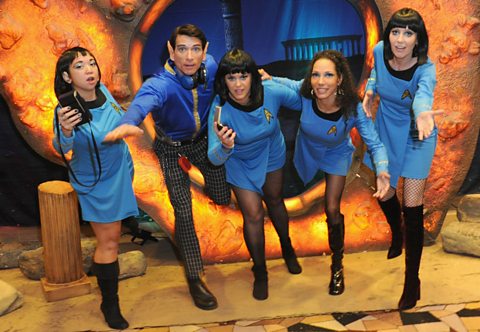For more than fifty years, Star Trek has enthralled audiences with its epic space adventures.
But how did it stand out from other science fiction, and why does it endure to this day?
┤¾¤¾┤½├¢ Bitesize looks at some of the ways that Star Trek broke new ground, changed popular culture, inspired real-life space exploration and changed the lives of its stars.
First contact
Star Trek was created by Gene Rodenberry, who sold his idea to television with a simple premise - an action series, like the popular westerns of the day, only in space! Aboard the starship Enterprise, led by Captain Kirk, the crew would seek new life and new civilisations, boldy going where no-one had gone before.
What made Star Trek different and gave greater depth than other shows of the time was the diversity of its regular characters. Rodenberry chose to imagine a future where humanity had united - a 23rd century where conflicts of race, gender or class were ancient history.
So the crew of the Enterprise included Uhura - a black, female communications officer; along with Sulu, an Asian-American helmsman, and Chekhov, a Russian on a show broadcast at the height of the Cold War. Then, at the centre of the show, was Spock - half-human, half Vulcan, suggesting the spirit of peace and love had voyaged beyond Earth.
When the opportunity of a role on Broadway was offered to Star Trek star Nichelle Nichols, she was ready to quit playing Lieutenant Uhura. Her decision to stay came at the insistence of civil rights leader Martin Luther King, who told her: You cannot. You cannot. For the first time on television, we are being seen as we should be seen every day, as intelligent beautiful, people who can sing, dance and go into space, be lawyers, teachers, and yet you don't see it on television until now.
"I could say nothing,ÔÇØ explained Nichols. ÔÇ£I just stood there realising that everything he said was the truth."
 Image source, Getty
Image source, GettyFandom
In the 1960s, after two years on television, Star Trek was set to be cancelled, because not enough people were watching. That should have been the end of it  just another quickly forgotten TV show given the chop
But instead, from nothing, the series had developed a strong, vocal and very enthusiastic fan following. When they heard the show faced cancellation, a frenzied letter-writing campaign began, demanding more episodes. It gained Star Trek a third and final year, in one of the first demonstrations of the power and influence of organised fandom.
When the original Star Trek did end, in 1969, its fans still refused to let it die. At a time before you could record your favourite series or stream episodes when you want, they campaigned for constant repeats on television, bringing new devotees to the showÔÇÖs cult following. With money to be made, merchandise grew, such as books, comics and toys. The first Star Trek convention took place in Manhattan in 1972, with such events then becoming ever more popular, and fans often dressing as their favourite heroes and villains. To many in the media and outside its fandom, these ÔÇÿTrekkiesÔÇÖ appeared eccentric and easy to mock. Even William Shatner ÔÇô Captain Kirk himself! ÔÇô joked that fans should ÔÇ£Get a life!ÔÇØ in a skit on comedy show Saturday Night Live. But, in our 21st century world of ComicCon and cosplay, where fandom is celebrated and can make or break a franchise, those originally derided Star Trek fans seem the start of things to come.
When the first Star Wars film was released in 1977, its unprecedented success made the rest of Hollywood seek their own sci-fi hit. Paramount, the owners of Star Trek, realised they already had just that, with a readymade following guaranteed to fill cinemas. The fans had won - in 1979, Star Trek would live again with ÔÇÿStar Trek: The Motion PictureÔÇÖ, and the continuing film and television franchise that we know today had begun.
 Image source, Getty
Image source, GettyThe final frontier
When NASA were completing construction of their latest orbiter in 1976, Star Trek fans again organised a letter campaign, and succeeded in having it named in tribute to their favourite show. Now there wasnÔÇÖt just an Enterprise on television screens, but one as part of the US space program as well. It was the start of a long relationship between NASA and the series, with cast members from Star Trek involved in NASA recruitment videos, and astronauts speaking fondly of their love of the show.
In 1992, Mae Jemison became the first black woman to travel into space, and has since been inducted into the National Women's Hall of Fame and the International Space Hall of Fame. Her inspiration to boldly journey to the stars? Star Trek, and in particular Nichelle NicholsÔÇÖ character, Lieutenant Uhura. In response, Jemison was invited to appear in an episode of Star Trek: The Next Generation a year after her space mission.
In 2021, Star Trek star William Shatner took an adventure worthy of Captain Kirk himself. At 90-years-old, he blasted off aboard the Blue Origin sub-orbital capsule, becoming the oldest person to go to space.
 Image source, Getty
Image source, Getty"Everybody in the world needs to do this," he said, shortly after landing back on Earth. "It was unbelievable I hope I never recover from this. I hope I can retain what I feel now. I don't want to lose it.
This article was published in September 2022.
The Doctor Who guide to Earth history
Just don't mention the Time Lord's involvement in your homework.

The hardest LOTR quiz in the world
Think you know all there is to know about the Lord of the Rings? Take our quiz and find out!

How 3D Printing Made Me a TikTok Star
Be amazed at how engineer Emily Yarid made her own wearable Iron Man suit.
